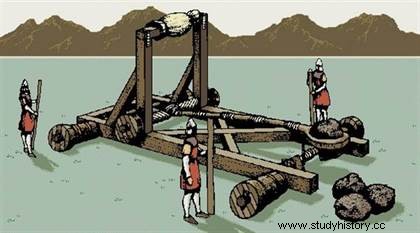 The catapult , ancestor of the trebuchet of the Middle Ages, made it possible to launch projectiles and flaming elements at the enemy camp. It was invented around 399 BC. J.C. following a policy of military innovation launched by Dionysius the Elder, tyrant of the Greek colony of Syracuse. Major projects were launched throughout the country which led to the creation of the famous catapult, a weapon of war that will be talked about for many centuries.
The catapult , ancestor of the trebuchet of the Middle Ages, made it possible to launch projectiles and flaming elements at the enemy camp. It was invented around 399 BC. J.C. following a policy of military innovation launched by Dionysius the Elder, tyrant of the Greek colony of Syracuse. Major projects were launched throughout the country which led to the creation of the famous catapult, a weapon of war that will be talked about for many centuries.
The catapult, multitasking launch platform
The catapult was a war machine used in antiquity and the Middle Ages to launch javelins, arrows, stones and other projectiles. The most powerful catapults were mounted on large wooden platforms. The magazine of a gigantic crossbow was pulled back by ropes and held in place by a latch. Another type of catapult used the principle of elasticity of twisting ropes to hurl heavy rocks over walls and across moats, with ropes wound over a winch to pull the propulsion mechanism. There were also portable catapults.
 From its conception, the catapult is used to throw rocks up to more than 400 meters (often from surrounding buildings), javelins (inflamed or not), and subsequently all kinds of projectiles such as clothes or dead animals suffering from contagious diseases. The weapon was used as early as the Second Sicilian War (410 – 340 BC) against Motya (397 BC), one of the main Carthaginian strongholds of Sicily .
From its conception, the catapult is used to throw rocks up to more than 400 meters (often from surrounding buildings), javelins (inflamed or not), and subsequently all kinds of projectiles such as clothes or dead animals suffering from contagious diseases. The weapon was used as early as the Second Sicilian War (410 – 340 BC) against Motya (397 BC), one of the main Carthaginian strongholds of Sicily .
A principle improved by the Romans
The catapult is finally designed in a fairly simple way, since it involves stretching a braided cable like a rubber band (made of rope, horsehair or even tendons) then to release the energy thus accumulated with a snap. Such power then makes it possible to pierce walls or to mow down whole battalions of reckless infantrymen in its path. A little later, the Romans will resume with excellence this invention by adding wheels to facilitate the mobility of the whole on the battlefields.
Other weapons were derived from the same process:the ballista and the trebuchet were the most famous of them.
The last large-scale military use of catapults dates back to trench warfare during the First World War. Catapults were used in the early years to throw grenades across no man's land towards enemy trenches... Today, catapults are used to help planes take off on aircraft carriers. To reach its take-off speed, the aircraft is propelled on the deck by a system of explosive charges, or by a hydraulic or pressurized steam system.
To go further
- 30,000 years of Thomas Craughwell inventions. Gründ, 2009.
- The 1001 inventions that changed the world by Jack Challoner. Flammarion, 2010.
